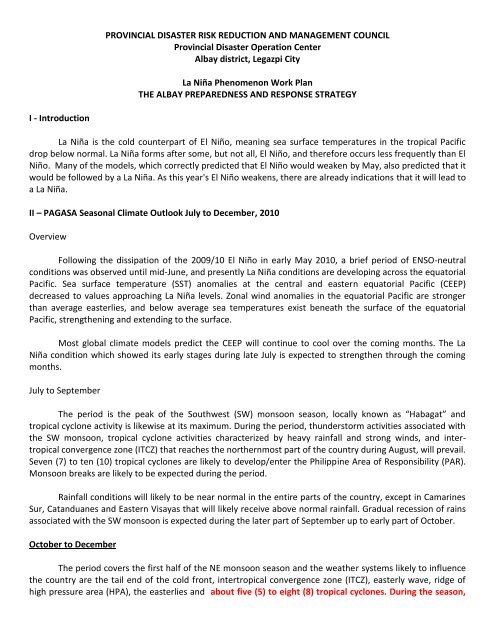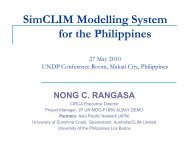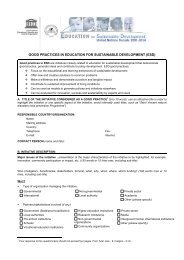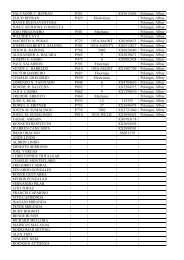PROVINCIAL DISASTER RISK REDUCTION AND MANAGEMENT ...
PROVINCIAL DISASTER RISK REDUCTION AND MANAGEMENT ...
PROVINCIAL DISASTER RISK REDUCTION AND MANAGEMENT ...
You also want an ePaper? Increase the reach of your titles
YUMPU automatically turns print PDFs into web optimized ePapers that Google loves.
<strong>PROVINCIAL</strong> <strong>DISASTER</strong> <strong>RISK</strong> <strong>REDUCTION</strong> <strong>AND</strong> <strong>MANAGEMENT</strong> COUNCIL<br />
Provincial Disaster Operation Center<br />
Albay district, Legazpi City<br />
La Niña Phenomenon Work Plan<br />
THE ALBAY PREPAREDNESS <strong>AND</strong> RESPONSE STRATEGY<br />
I - Introduction<br />
La Niña is the cold counterpart of El Niño, meaning sea surface temperatures in the tropical Pacific<br />
drop below normal. La Niña forms after some, but not all, El Niño, and therefore occurs less frequently than El<br />
Niño. Many of the models, which correctly predicted that El Niño would weaken by May, also predicted that it<br />
would be followed by a La Niña. As this year's El Niño weakens, there are already indications that it will lead to<br />
a La Niña.<br />
II – PAGASA Seasonal Climate Outlook July to December, 2010<br />
Overview<br />
Following the dissipation of the 2009/10 El Niño in early May 2010, a brief period of ENSO-neutral<br />
conditions was observed until mid-June, and presently La Niña conditions are developing across the equatorial<br />
Pacific. Sea surface temperature (SST) anomalies at the central and eastern equatorial Pacific (CEEP)<br />
decreased to values approaching La Niña levels. Zonal wind anomalies in the equatorial Pacific are stronger<br />
than average easterlies, and below average sea temperatures exist beneath the surface of the equatorial<br />
Pacific, strengthening and extending to the surface.<br />
Most global climate models predict the CEEP will continue to cool over the coming months. The La<br />
Niña condition which showed its early stages during late July is expected to strengthen through the coming<br />
months.<br />
July to September<br />
The period is the peak of the Southwest (SW) monsoon season, locally known as “Habagat” and<br />
tropical cyclone activity is likewise at its maximum. During the period, thunderstorm activities associated with<br />
the SW monsoon, tropical cyclone activities characterized by heavy rainfall and strong winds, and intertropical<br />
convergence zone (ITCZ) that reaches the northernmost part of the country during August, will prevail.<br />
Seven (7) to ten (10) tropical cyclones are likely to develop/enter the Philippine Area of Responsibility (PAR).<br />
Monsoon breaks are likely to be expected during the period.<br />
Rainfall conditions will likely to be near normal in the entire parts of the country, except in Camarines<br />
Sur, Catanduanes and Eastern Visayas that will likely receive above normal rainfall. Gradual recession of rains<br />
associated with the SW monsoon is expected during the later part of September up to early part of October.<br />
October to December<br />
The period covers the first half of the NE monsoon season and the weather systems likely to influence<br />
the country are the tail end of the cold front, intertropical convergence zone (ITCZ), easterly wave, ridge of<br />
high pressure area (HPA), the easterlies and about five (5) to eight (8) tropical cyclones. During the season,
tropical cyclones move on a more westerly track across central and southern parts of Luzon and Visayas with<br />
secondary tracks over northern Mindanao.<br />
For October to December season, rainfall conditions are expected to be above normal in most parts<br />
of Luzon, Northern Panay, Autonomous Region of Muslim Mindanao (ARMM) and Southern Mindanao. The<br />
rest of Luzon, major portions of Visayas and Mindanao area will likely experience near normal rainfall<br />
conditions.<br />
PAGASA will continue to closely monitor these conditions and regular updates/advisories shall be<br />
issued as appropriate. Concerned agencies are advised to take precautionary measures to mitigate the<br />
potential adverse impacts of this La Niña episode.<br />
Years of onset of strong or moderate La Niña (Cold Phase) Events<br />
1930’s 1940’s 1950’s 1960’s 1970’s 1980’2 1990’s 2000’s<br />
1938 ----- 1950 1964 1970 1988 1995 2009<br />
1955 1971 1998 2010<br />
1956 1973<br />
1975<br />
The 12 Worst Typhoon Events in the Philippines<br />
(Typhoons2000.com)<br />
Typhoon Date Strength kph Deaths<br />
1. Reming Nov 28-Dec 1 2006 320 734<br />
2. Milenyo Sept 2006 14<br />
3. Loleng Oct 14-24 1998 250 303<br />
4. Rosing Oct 30 - Nov. 4, 1995 260 936<br />
5. Kadiang Sept 30-Oct 7 1993 130 576<br />
6. Ruping Nov. 10-14, 1990 220 748<br />
7. Uring Nov. 2-7 1991 95 5,101<br />
8. Sisang Nov 23-27, 1987 240 979<br />
9. Nitang Aug. 31-Sept 4, 1984 220 1,363<br />
10. Undang Nov 3-6 1984 230 895<br />
11. Sening Oct 11-15, 1970 275 768<br />
12. Amy Dec 6-19 1951 240 991
III – Possible Effects of La Niña<br />
Effects<br />
1. Flooding<br />
2. Landslide<br />
3. Mud flow (lahar)<br />
Affected Sectors<br />
1. Agriculture, aquaculture, residents in the low lying areas and those near the<br />
river channels, livelihood, infrastructure like dam, weak dikes, bridges and<br />
those exposed to heavy flood.<br />
2. Upland agriculture, residents, some schools along the slopes, forests and<br />
some minor forests.<br />
3. Roads and bridges, residents, agriculture along the slope of Mayon Volcano.<br />
IV - Measures to Mitigate its Effects<br />
Activities<br />
Status/Recommendation<br />
1. Creation of Task Force La Niña Created under Executive Order 2010-06<br />
2. Flood and Landslide Risk Mapping. Flood and landslide risk maps exist but require<br />
Strengthen community-based real time detailed mapping to determine population at<br />
warning system using rain gauge stations risk and critical resources by barangay.<br />
3. Education and Training<br />
a. Rubber boat operators<br />
b. Balangay sa Barangay<br />
(Upon Procurement of Rubber Boats for<br />
distribution to all municipalities and cities of<br />
Albay Province)<br />
4. Round-table discussions with the LGU<br />
Chief Executives<br />
5. Community Planning Workshop on<br />
Warning and Evacuation<br />
Still to be conducted pending financial<br />
support requiring an amount of P 13.7M for<br />
the rubber boat operators and balangay sa<br />
barangay with AECID support. The cost<br />
includes procurement of rubber boat.<br />
To be conducted middle of September. We<br />
are opting for LCEs (instead of direct to<br />
barangay chiefs due to their coming<br />
elections). They will then disseminate to their<br />
constituent barangays.<br />
To be conducted by LGUs with technical<br />
support from APSEMO. Will be taken up in<br />
item 4.<br />
Important but no proposal yet for possible<br />
funding negotiation.<br />
6. Improvement of rural and urban water<br />
system to avoid possible contamination.<br />
7. Improvement of river control system. Must be included in the priority project upon<br />
recommendation or proposal by LGUs<br />
concerned or PEO or DPWH<br />
8. Improvement of irrigation system. Must be included in the priority projects<br />
upon recommendation or proposal by LGUs<br />
concerned and NIA<br />
9. Strengthen Barangay Response<br />
Mechanism.<br />
10. Close coordination with PAGASA<br />
Training Workshops on communication<br />
protocol and evacuation procedures. LGU-<br />
APSEMO partnership.
V - Implementation Strategy<br />
1. La Niña Task Force created under Executive Order No. 2010-06 shall be responsible in the project<br />
implementation.<br />
2. An initial budget of P5M is appropriated for the operations of the Task Force<br />
3. APSEMO will remain the secretariat of the Task Force.<br />
4. Members of the task force will have to continue its regular meeting this September, 2010 on.<br />
5. Implementation of the priority funded La Niña Projects are to be undertaken by the LNTF member<br />
agencies upon approval by the governor and PDCC Chairman.<br />
6. Request to expedite the release of financial support from AECID for the procurement of rubber boats,<br />
support preparedness equipment and the training for the rubber boat operators and the balangay sa<br />
barangay.<br />
7. Submission of the LGUs PEO, NIA of proposal for immediate funding support from the National<br />
Government Infra Fund and/or National Calamity Fund per item VI below.<br />
VI - Suggested Institutional Arrangements for Project Implementation under Respective Existing Fund or for<br />
Immediate Funding Support<br />
Government<br />
Office/Department<br />
Agriculture<br />
DCC/Legal<br />
NFA/DSWD/PSWDO/<br />
PNRC<br />
Landslide Advance<br />
Monitoring Team<br />
PAGASA, MGB,<br />
PHIVOLCS, LGUs, DPWH<br />
Program of Activities<br />
1. Information & education campaign<br />
2. Plant/develop water-resistant varieties<br />
3. Land and water management practices (e.g. Improvement of drainage<br />
system)<br />
4. Alternative livelihood<br />
5. Suitable livestock production system<br />
6. Fodder development and management<br />
7. Animal health programs<br />
8. Storage and post-harvest management<br />
9. Increase short-season crop production to support nearby provinces<br />
affected by La Niña.<br />
10. Develop marketing scheme<br />
1. Organize Task Force<br />
2. Declare State of Calamity<br />
3. International cooperation<br />
4. Institutionalize Early Recovery Program<br />
1. Food security<br />
2. Storage and post harvest<br />
1. Flood and landslide monitoring<br />
2. Warning and evacuation<br />
1. Analysis of hydro-meteorological data<br />
2. Issuance of flood warning and precipitation data<br />
3. Demarcation of flood prone areas<br />
4. Demarcation of landslide prone areas with support from MGB.
5. Demarcation of lahar prone areas with support from PHIVOLCS.<br />
6. Develop information for decision making<br />
PHO, DOH, PEO, Water<br />
Districts, LWUA<br />
DTI, BFAD, DA<br />
Forestry<br />
Social Services and<br />
Financial Institutions<br />
BFP, LGUs, AFP, PNP<br />
NIA<br />
Prepared by:<br />
CEDRIC D. DAEP, MBA<br />
Department Head<br />
1. Inventory of existing safe water facilities<br />
2. Community education and issuances of health advisories and public<br />
health monitoring and services<br />
1. Monitoring and control of prices of basic and prime commodities,<br />
agricultural and minor forest products, foods and drugs<br />
1. Protection of catchment<br />
2. Watershed management<br />
1. Crop Insurance<br />
2. Credit facilities<br />
3. Relief Goods and Services<br />
1. Transport of drinking, domestic waters<br />
2. Communication System<br />
1. Repair and maintenance of damaged irrigation system<br />
2. Water resource development<br />
Approved by:<br />
GOV. JOEY SARTE SALCEDA







